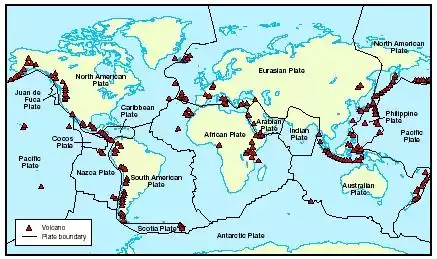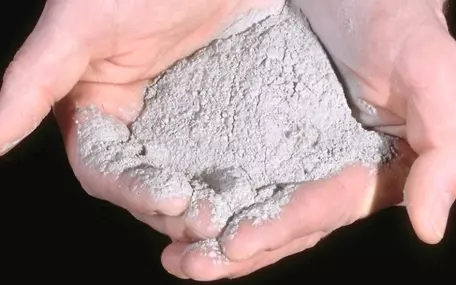Volcanic Ash: More Than Just A Science Project
Author: Gretchen Williams
This case study is part of a collection of pages developed by students in the 2012 introductory-level Geology and Human Health course in the Department of Earth Sciences, Montana State University. Learn more about this project.
Hazards Of Volcanic Ash
A multitude of dangerous particals and gases, such as aerosols, are carried in volcanic ash. Some of these include;
- Carbon dioxide
- Sulfates (sulfur dioxide)
- Hydrochloric acid
- Hydroflouric acid
These each have different but serious effects on human health if exposed, which will be discussed later.
In addition, volcanic ash can cause reduced visibility, and it is recommended that precautions are taken when driving.
Sources: Where Does It Come From?
There are volcanoes found all over the Earth, particularly at plate boundaries (see figure 1). This is due to the collision of plates, which causes uplift in the overlying crust. This uplift results in the formation of mountainous landforms; melting of the crust due to frictional heating is what creates magma, which can erupt out of these mountains when pressure gets too high.
Some of the most notable volcanic eruptions are:
- the 1783 eruption of Mt. Laki in Iceland
- released clouds of poisonous flourine and sulfur dioxide which killed off about 50% of the livestock population
- that summer in Great Britain was known as "sand-summer" due to ash carried over the Atlantic
- poisonous clouds spread over Europe, and a buildup of aerosols caused a cooling effect in the entire Northern Hemisphere
- the 1815 eruption of Mt. Tambora in Indonesia
- gas releases caused the Stratosphere to change drastically
- noxious ash and poisoned rain clouds killed off vegetation
- the 1902 eruption of Mt. Pelee in Martinique
- spewed toxic clouds traveling at speeds of 600mph
- largest eruption in the 20th century
For further information on volcanoes around the world, visit http://www.mapsofworld.com/major-volcanoes.htm.
Source: http://www.chm.bris.ac.uk/webprojects2003/silvester/Page6Famous.htm
How Volcanic Ash Travels Around The Earth System
Unfortunately, volcanic ash can be very easily transported around the Earth system. The movement of volcanic ash depends on:
- eruption column height
- ash particle size
- amount of ash ejected into the atmosphere
- climatic conditions - wind direction, strength, and humidity
Larger eruptions of ash can travel hundreds to thousands of kilometers downwind from the source, but can effect the climate in places on the other side of the world. Ash carried into the atmosphere and spread far from the epicenter can block the sun's rays, resulting in a cooler Earth. The ash can also return to the Earth's surface by means of precipitation; ash particles caught in clouds in the atmosphere fall back down to Earth with rain, snow, ect.
Source: http://en.wikipedia.org/wiki/Volcano
Bioavailability
Volcanic ash contaminates the biosphere through inhalation by humans and animals, and can also effect crops growing in an area with large amounts of ash. When inhaled, the fibers are deposited in air passages and on lung cells.
Impacts on Human Health
Inhalation of volcanic ash can be very detrimental to human health, due to the harmful aerosols and poisonous gases the ash is made up of. Health effects inlcude respiratory problems, eye problems, and skin irritiation.
1. Respiratory symptoms (short-term)
- runny nose
- sore throat/coughing
- wheezing/shortness of breath
- possible bronchitus
2. Eye symptoms (short-term)
- may become itchy or bloodshot
- corneal abrasions or scratches
- can result in conjunctivitis
- tearings
One long-term effect of volcanic ash is silicosis. Silicosis is a disease resulting in lung impairment and scarring, from exposure to particles of free crystalline silica. Minerals that are associated with silicosis include quartz, cristobalite, and tridymite, all potentially present in volcanic ash.
Volcanic ash can also contaminate the water supply.
Sources: http://volcanoes.usgs.gov/ash/health/index.html; http://en.wikipedia.org/wiki/Volcanic_ash#Human_and_Animal_Health
Prevention or Mitigation
Fortunately, there are many ways to avoid and protect yourself againsts the dangers of volcanic ash. Precautions for the general public as published by the Federal Emergency Management Agency (FEMA) are outlined below:
- wear protective clothing, goggles, and dust masks
- seal buildings
- those with pre-existing respiratory conditions should stay inside or evacuate
- it is recommended to stay inside in general
- wet any dust and ash particles to prevent movement
- when driving, keep a proper distance in between cars due to reduced visibility
- avoid exertion, since heavy breathing leads to deeper inhalation of particles into the lungs
Source: http://volcanoes.usgs.gov/ash/health/index.html
Recommended Readings
1. "Icelandic volcanic ash alert grounds UK flights." BBC News. 15 April 2010. http://news.bbc.co.uk/2/hi/8621407.stm
- This article about a 2010 Iceland volcanic eruption discusses the affects it had on air travel in countries all across Europe. The extent of the ash cloud spread over Iceland, Norway, Sweden, Finland, the UN, and even a small part of Russia.
2. "Volcanic ash health advice." NHS Choice. 16 April 2010. https://www.networks.nhs.uk/news/volcanic-ash-health-advice
- This articles discusses the health effects from the Iceland eruption described in the article above, which includes information from the Health Protection Agency (HPA).
3. Gudmundsson, Gunnar. "The Clinical Respiratory Journal." Wiley Online Library. Blackwell Publishing Ltd, 29 November 2010. https://onlinelibrary.wiley.com/doi/full/10.1111/j.1752-699X.2010.00231.x
- This article discusses the repiratory effects of volcanic ash, with a reference to the Iceland eruption in the first two articles.
Related Links
- Volcanic Ash - U.S. Geology Survey (USGS): http://volcanoes.usgs.gov/ash/
- Provides information on the hazards of volcanic ash, what makes up volcanic ash, and how you can protect your home and family against the dangers of volcanic ash
- Volcanic Ash - Environmental Protection Agency (EPA): http://www.epa.gov/aging/resources/other/volcanic_ash.htm
- Provides information on the health affects of volcanic ash and what you can do to avoid them
- Volcanic Ash - Geology.com: http://geology.com/articles/volcanic-ash.shtml
- Provides information on the different kinds of ash plumes, the dangers of volcanic ash to humans, and how volcanic ash disrupts everyday life
Bibliography
1. "Famous Volcanoes." University of Bristol. 2012. http://www.chm.bris.ac.uk/webprojects2003/silvester/Page6Famous.htm.
2. "Volcano." Wikipedia. 28 November 2012. http://en.wikipedia.org/wiki/Volcano.
3. "Volcanic Ash." Wikipedia. 13 November 2012. http://en.wikipedia.org/wiki/Volcanic_ash#Human_and_Animal_Health.
4. "Volcanic Ash: Effects & Mitigation Strategies." U.S. Geology Survey. 03 February 2009. http://volcanoes.usgs.gov/ash/health/index.html.




![[creative commons]](/images/creativecommons_16.png)


